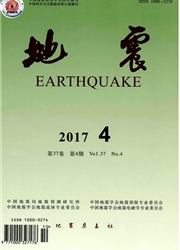

 中文摘要:
中文摘要:
基于GPS多期复测资料,利用最小二乘配置方法计算川滇地区应变参数,分析该区域应变率场分布及其变化特征并探讨其分布与强震关系。研究结果表明:1各时段应变率场空间分布的明显变化应属于大于GPS资料误差的真实地壳构造形变信息;2最大剪应变率及第一、第二剪应变率的结果反映了走滑断裂对区域变形的显著控制;3主应变率,东西、南北向应变率场动态结果反映的汶川地震孕震的空间尺度较大;4在本区大致反映北东向与北西向剪切变形的第一剪应变率、东西向应变率、南北向应变率及最大剪应变率与6级以上地震对应较好。
 英文摘要:
英文摘要:
Based on repeated GPS data, least square collocation method is used to calculate the strain parameters in the Sichuan--Yunnan region. We analyse regional strain rate field distribution and its variation characteristics and relationship between strain rate field dis- tribution and earthquake occurrences. The results show that: (1) spatial distribution of strain rate which has some obvious change is greater than the error of GPS data at each time may be real tectonic deformation information; (2) results of maximum shear strain, first shear strain and second shear strain reflect that strike slip faults have a significant control over deformation; (3) results of principal strain, north--south strain and east-- west strain reflect that influence range of the 2008 Wenchuan earthquake is larger; (4) the first shear strain rate reflect north--east and north--west shear deformation, the east west, north--south strain and maximum shear strain are corresponding to earthquake of magnitude 6 or over in this region.
 同期刊论文项目
同期刊论文项目
 同项目期刊论文
同项目期刊论文
 期刊信息
期刊信息
